Have you ever wondered what fruits used to look like? Throughout history, fruits have undergone remarkable transformations in appearance. From the ancient past to the present day, the aesthetics of our favorite fruits have evolved in fascinating ways. Join me on a journey through time as we explore the historical fruit appearance and the changes it has undergone over the centuries.
Key Takeaways:
- Throughout history, fruits have transformed in appearance due to selective breeding and domestication.
- Ancient fruits may have had different shapes, colors, and even tastes compared to their modern counterparts.
- Selective breeding has played a major role in shaping the way fruits look and taste today.
- Understanding the ancient fruit appearance helps us appreciate the vast diversity and evolution of our favorite fruits.
- The aesthetic evolution of fruits showcases the ingenuity and creativity of farmers and horticulturists throughout history.
The Transformation of Watermelon
Watermelons have undergone a fascinating transformation in appearance over the centuries. Through the process of selective breeding and cultivation, watermelons have evolved from their ancient predecessors into the juicy, sweet fruits we know today.
In a 17th-century painting, we can catch a glimpse of what watermelons used to look like. The painting depicts a watermelon with swirls and triangular pie-shaped pieces, quite different from the smooth, elongated shape of modern watermelons. The interior of the older watermelon appears to be less fleshy and more rind-like.
“The evolution of watermelon appearance is a testament to human ingenuity and our ability to shape the characteristics of the fruits we consume.” – Watermelon Enthusiast
It is important to note that the painting might depict an unripe watermelon, as the absence of the characteristic red hue suggests. However, the presence of black seeds indicates that it could still be a ripe specimen.
To better understand the historical watermelon characteristics and the changes in its appearance, let’s take a look at the following table:
| Historical Watermelon Appearance | Modern Watermelon Appearance |
|---|---|
| Swirls and triangular pie-shaped pieces | Smooth, elongated shape |
| Less fleshy interior | Juicy, crimson-red flesh |
| Potentially unripe | Sweet and ripe, indicated by black seeds |
As we can see, the evolution of watermelon appearance is a fascinating journey that showcases the ingenuity and creativity of humans in shaping the characteristics of the fruits we enjoy today.
From Wild Bananas to Modern Delights
When we think of bananas, we picture the sweet and creamy fruit that is a staple in many households. But did you know that bananas have evolved over time, going through significant changes in appearance and taste? Let’s explore the fascinating journey of bananas from their wild origins to the modern delights we enjoy today.
Thousands of years ago, bananas existed as two wild varieties with large, hard seeds. These bananas were far from the sweet and delicious fruit we know today. Through the process of selective breeding, humans began transforming these wild bananas into something more desirable.
Over time, bananas underwent various changes in appearance as humans selected for traits that suited their preferences. Their seeds became smaller, making them easier to eat. The taste also improved, with modern bananas boasting a sweeter flavor. Along with these changes, bananas developed higher nutritional content, providing us with essential vitamins and minerals.
Nowadays, bananas are a far cry from their wild ancestors. They have a vibrant yellow color, a smooth texture, and a sweet flavor that delights our taste buds. Their appearance and taste have been tailored to suit our preferences, making them a popular fruit worldwide.
“Bananas have come a long way from their wild origins. Through selective breeding, we have transformed them into one of the most beloved fruits. It’s incredible to think about the evolution of bananas and how we have shaped them to suit our needs.”
Take a look at the table below for a summary of the changes in banana appearance:
| Historical Banana Characteristics | Modern Banana Traits |
|---|---|
| Wild bananas with large, hard seeds | Bananas with smaller seeds |
| Bland taste | Sweet and desirable flavor |
| Lower nutritional content | Higher nutritional content |
As you can see, the evolution of bananas has been remarkable. From their humble beginnings as wild fruits to the delicious and nutritious delights we enjoy today, bananas have undergone a significant transformation.
The image above showcases the evolution of bananas, highlighting the changes in their appearance over time. From their wild, seed-filled form to the smooth and sweet fruit we know and love, bananas have truly come a long way.
The Evolution of Eggplant
Eggplants, also known as aubergines, have undergone fascinating transformations in their appearance throughout history. Ancient eggplants came in a variety of colors, including white, yellow, azure, and purple. They even had spines, which gave them a distinct and unique appearance.
However, through centuries of selective breeding by farmers and horticulturists, these spines were gradually eliminated, resulting in the larger, oblong-shaped eggplants that we commonly see today. The rich purple skin of modern eggplants has become synonymous with their identity.
The transformation of eggplant varieties is a testament to human innovation and the pursuit of culinary excellence. By selectively breeding eggplants with desired traits, such as smoother skin and increased size, farmers have been able to create more aesthetically pleasing and flavorful eggplants.
In addition to the familiar purple eggplants, there are now various other colors, sizes, and shapes available in the market. From slender Japanese eggplants to petite white varieties, the diversity of modern eggplants is remarkable.
Ancient Eggplant Varieties and Characteristics
Let’s take a closer look at some key characteristics of ancient eggplants and how they differ from their contemporary counterparts:
| Eggplant Variety | Color | Shape | Spines |
|---|---|---|---|
| White Eggplant | White | Oblong | Present |
| Yellow Eggplant | Yellow | Oblong | Present |
| Azure Eggplant | Azure | Oblong | Present |
| Purple Eggplant | Purple | Oblong | Present |
As you can see, ancient eggplants exhibited a range of vibrant colors and retained their characteristic spines. These variations in color and texture contributed to a diverse culinary experience for ancient civilizations.
Through selective breeding, farmers and horticulturists have cultivated eggplants that are not only visually appealing but also showcase enhanced flavors and textures. The journey of eggplants is a testament to our ability to shape and transform nature’s gifts to suit our preferences.
Whether you prefer the classic purple eggplant or enjoy experimenting with different varieties, eggplants continue to be a staple ingredient in various cuisines around the world. Their adaptability and versatility make them a fascinating example of how fruits and vegetables can evolve and adapt to human needs and tastes.
The Colorful History of Carrots
Ancient carrots have a fascinating history of transformation. Originally, carrots had an off-white or purple color and featured a thin, forked root. Over time, however, they underwent significant changes in appearance. Through the process of selective breeding, carrots gradually lost their purple pigment and transitioned into the yellow carrots we know today.
Carrots didn’t stop there. Thanks to the dedicated efforts of farmers, more significant transformations occurred. Selective breeding techniques focused on enhancing the taste and size of carrots, resulting in the development of large, tasty orange roots that dominate the vegetable landscape.
Through careful selection and cultivation, generations of farmers have shaped the carrots we enjoy today. The evolution of carrots showcases the power of human ingenuity and our ability to influence the appearance of plants to our liking.
Table: Changes in Carrot Color and Appearance Over Time
| Era | Carrot Color | Carrot Appearance |
|---|---|---|
| Ancient Times | Off-white or Purple | Thin, Forked Roots |
| Selective Breeding | Transition to Yellow | Enhanced Taste and Size |
| Modern Varieties | Various Shades of Orange | Large, Tasty Orange Roots |
As seen in the table, the evolution of carrots showcases a remarkable journey of color and appearance. From ancient off-white and purple roots to the vibrant orange carrots of today, this transformation highlights the everchanging nature of vegetables and the impact of human intervention.
Carrot Color Varieties
- Orange: The most common and widely available variety.
- Purple: A revival of the ancient purple carrots, prized for their rich pigmentation and high antioxidant content.
- White: Known for their mild flavor and subtle sweetness.
- Yellow: A vibrant alternative to orange carrots, often sought after for their novelty.
The diversity of carrot colors enhances culinary experiences, allowing for unique visual presentations and adding variety to dishes.
The image above visually depicts the changes in carrot appearance over time, reflecting the colorful history of this versatile vegetable.
The Transformation of Corn
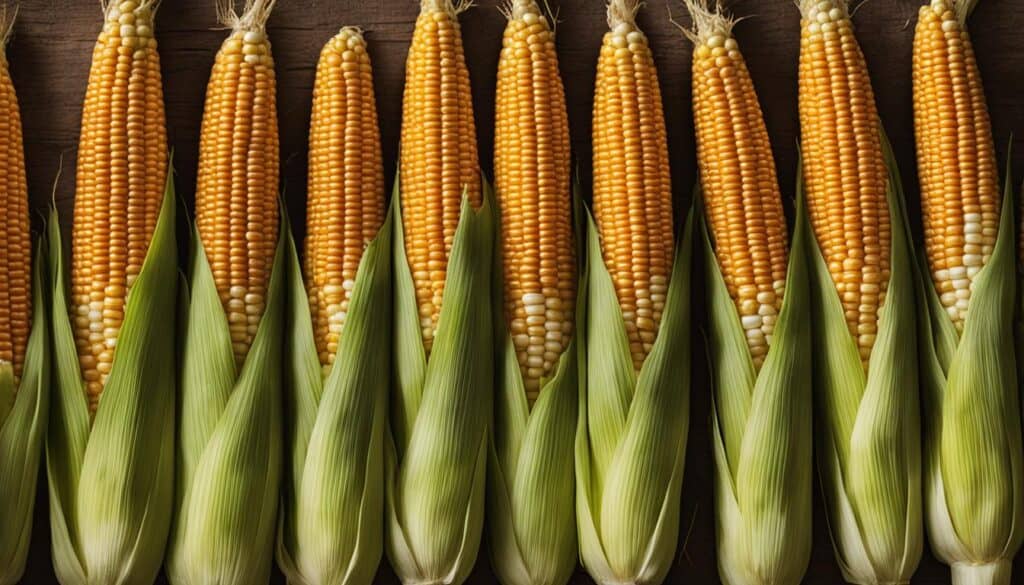
When we think of corn today, we often picture plump, juicy kernels bursting with sweetness. But it wasn’t always this way. Corn has undergone a remarkable transformation over time through the process of selective breeding.
Ancient corn, also known as maize, looked vastly different from the corn we consume today. Picture dry, hard kernels that were barely edible, resembling a raw potato rather than the golden ears we’re accustomed to. The early versions of corn lacked the sweetness and juiciness that we associate with this popular vegetable.
Over centuries, Native Americans and early farmers selectively bred corn to enhance its desirable characteristics. They focused on traits like taste, size, and ease of peeling, leading to the evolution of corn into a more palatable and convenient crop.
The transformation of corn can be seen in its appearance and taste. Today, corn is much larger, with plumper kernels filling the cob. The vibrant yellow color and juicy texture make it a staple on our dinner tables and at summer barbecues.
Changes in Corn Appearance
The changes in corn appearance are evident when comparing ancient corn to modern varieties. Take a look at the table below to see the differences:
| Ancient Corn | Modern Corn |
|---|---|
| Small, dry kernels | Large, plump kernels |
| Varied colors (yellow, white, blue, red) | Primarily yellow |
| Difficult to peel | Easier to peel |
As you can see, the evolution of corn has resulted in a significant transformation when it comes to appearance and overall eating experience.
But it’s not just the appearance that has changed. Through selective breeding, corn breeders have also increased the sugar content in corn, making it sweeter and more enjoyable to eat. This has made corn a versatile ingredient in various dishes, from cornbread and tortillas to creamy corn chowder.
Throughout its history, corn has been a staple food in many cultures. Its transformation over time showcases the ingenuity and dedication of those who worked to improve its characteristics. Today, we can enjoy corn in all its delicious forms, thanks to the generations of farmers and breeders who have shaped this remarkable crop.
As we continue to appreciate the evolution of corn, it’s important to acknowledge the efforts and expertise of those who have contributed to its transformation. Our modern corn is a testament to the power of selective breeding and the impact it can have on the characteristics of a crop.
The Evolution of Peaches
When we think of peaches today, we envision juicy, sweet fruits with vibrant, golden flesh. But did you know that peaches haven’t always looked this way? The appearance of peaches has undergone a remarkable transformation over time, thanks to the process of selective breeding.
In their early days, peaches were quite different from the plump and luscious fruits we enjoy now. These early peaches resembled small cherries, with limited flesh and a unique earthy, slightly salty taste. Despite their modest size, these ancient peaches played an essential role in the evolution of this beloved fruit.
Over thousands of years, farmers and cultivators selectively bred peaches, choosing the individuals with desirable traits and characteristics. This deliberate selection led to significant changes in the appearance and taste of peaches. Through this process, peaches gradually grew larger, developing a considerable amount of juicy and delectable flesh.
But that’s not all – the sweetness of modern-day peaches is also a result of the ongoing transformation. The early peaches lacked the intense sweetness we associate with peaches today. But through careful breeding, the natural sugars within peaches became more concentrated, enhancing their overall flavor profile.
It’s fascinating to witness how peaches have evolved over time, from their humble and salty beginnings to becoming the juicy and sweet delights we savor today. This transformation in peach appearance showcases the power of selective breeding and the remarkable changes that can occur over centuries.
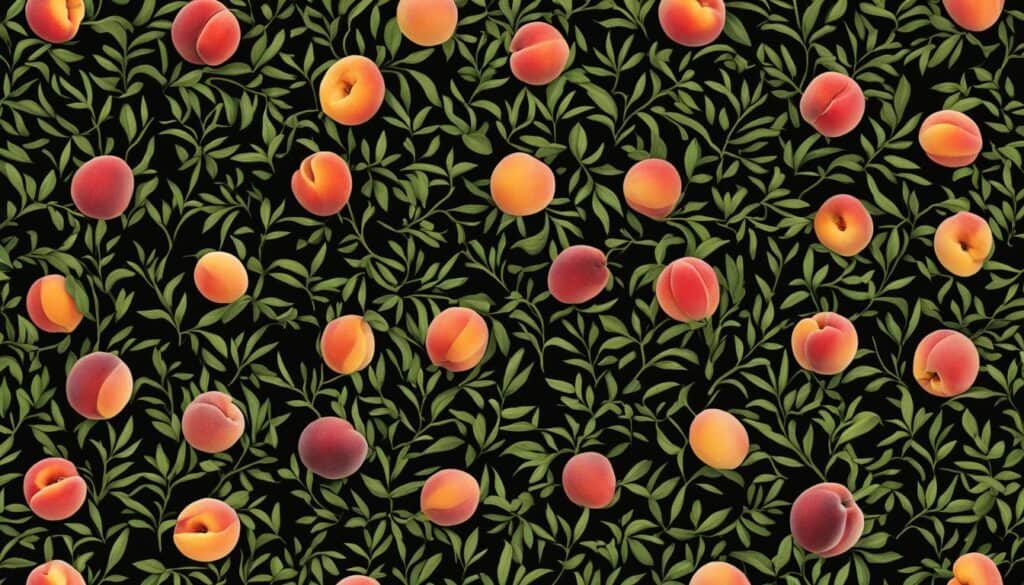
| Era | Description |
|---|---|
| Ancient Times | Small, cherry-like fruits with limited flesh and an earthy, slightly salty taste. |
| Selective Breeding | Gradual increase in size, development of larger flesh, and enhanced sweetness. |
| Modern-day Peaches | Large, juicy fruits with vibrant golden flesh and a deliciously sweet flavor. |
The Evolution of Apples
Apples have gone through a captivating transformation over time, evolving from their ancient ancestors to the delicious fruits we enjoy today. The journey of apple evolution showcases the changes in their appearance and taste that have been influenced by selective breeding and domestication.
The predecessor of the modern apple is the Asian wild apple, which bears a close resemblance to present-day apples. However, these wild apples had a notably sour taste. Through careful selection and breeding, humans have played an integral role in refining the characteristics of apples, ultimately making them sweeter and larger.
One of the earliest recorded instances of apple cultivation can be traced back to ancient Mesopotamia, where the fruit was prized for its versatility and nutritional value. As civilizations advanced and trade routes expanded, apples spread across the globe, leading to the cultivation of various apple varieties.
Over the centuries, apple growers have developed an extensive array of apple cultivars, each with its unique appearance, texture, and flavor. From the classic Red Delicious to the tart Granny Smith, there is an apple variety to suit every palate.
Apple Varieties Throughout History
Throughout history, apples have captivated individuals with their diverse range of colors, sizes, and tastes. Let’s take a closer look at the evolution of some notable apple varieties:
“The apple is the pomaceous fruit of the apple tree, species Malus domestica in the rose family (Rosaceae). It is one of the most widely cultivated tree fruits.”
– Encyclopedia Britannica
| Apple Variety | Appearance | Taste |
|---|---|---|
| Gala | Red and yellow stripes with a crisp texture | Sweet and slightly tart |
| Golden Delicious | Golden yellow skin with a sweet and tender flesh | Mild and sweet |
| Granny Smith | Green skin with a tart and crunchy flesh | Tart and tangy |
These are just a few examples of the incredible diversity within the world of apples. From the rich, honey-like flavor of the Fuji apple to the floral notes of the Pink Lady, apple enthusiasts have a seemingly endless array of choices when it comes to selecting their favorite fruit.
Over time, apples have become an iconic symbol of health, temptation, and abundance. From the mythical Garden of Eden to the apple-centric folklore in various cultures, these fruits have left an indelible mark on human history.
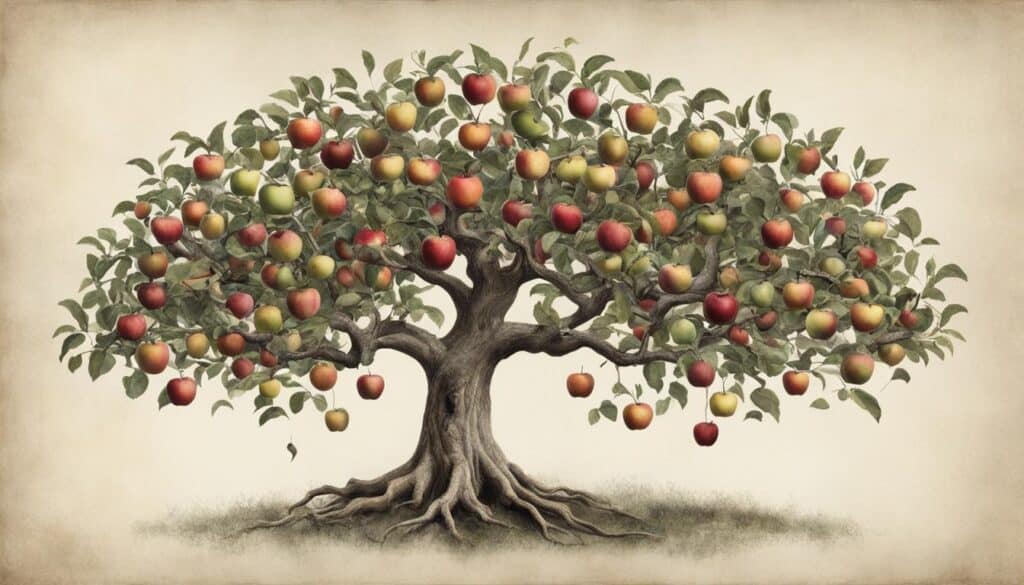
Through the evolution of apples, we can witness the extraordinary power of selective breeding in shaping the appearance and taste of fruits. Apples continue to be a beloved and versatile staple in culinary creations, from pies and sauces to fresh snacks. As we appreciate the abundance and diversity of apple varieties available, we can marvel at the long journey that these remarkable fruits have taken to reach our tables.
The Journey of Tomatoes
Tomatoes have undergone remarkable changes in appearance and usage throughout history. Early varieties of tomatoes featured small green or yellow fruits that were primarily used for cooking purposes. These tomatoes lacked the vibrant red color and juicy texture that we are familiar with today.
In fact, when tomatoes were first introduced in Europe, they were met with fear and skepticism. This was due to the belief that their acidic nature could leach lead from pewter plates, leading to lead poisoning. As a result, tomatoes were initially regarded with caution and were not widely consumed.
However, through the process of selective breeding, tomatoes evolved into the juicy and red fruits that we now enjoy. Over time, farmers and breeders focused on enhancing the desirable characteristics of tomatoes, such as size, flavor, and appearance. This led to the development of various cultivars that offered a range of flavors and sizes.
Image:
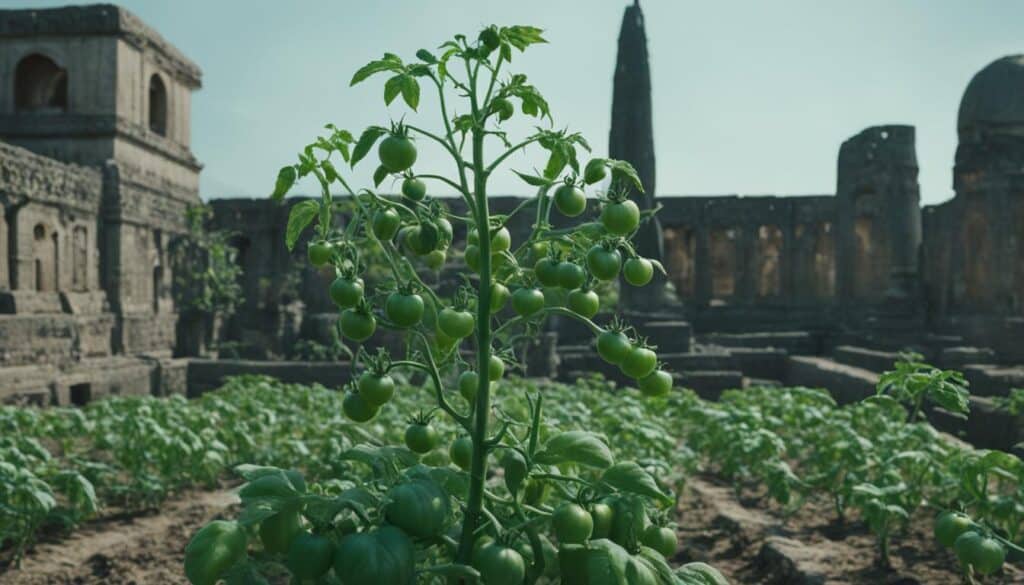
Today, tomatoes come in countless varieties, each with its own unique characteristics. From cherry tomatoes to beefsteak tomatoes, the diversity in size, color, and flavor is truly remarkable. Tomatoes have become a staple in many cuisines around the world and are enjoyed both raw and cooked in a variety of dishes.
The journey of tomatoes is a testament to the power of selective breeding and the dedication of farmers and breeders in transforming a small, unassuming fruit into a culinary superstar.
Through centuries of evolution and refinement, tomatoes have become a versatile and beloved ingredient. Their sweet acidity adds depth of flavor to salads, sandwiches, sauces, and more. Whether it’s a classic Caprese salad or a hearty marinara sauce, tomatoes continue to play a pivotal role in our culinary traditions.
The Diversity of Modern Eggplants
When it comes to eggplants, the modern varieties offer a stunning array of colors, shapes, and sizes. Gone are the days when eggplants were simply dark purple and oval-shaped. Today, you can find eggplants in a rainbow of colors, including white, green, striped, and even vibrant shades of purple.
While the average size of an eggplant ranges from six to nine inches in length, there are also unique Japanese varieties that are longer, thinner, and more delicate. These slender eggplants offer a different taste experience and are perfect for stir-fries and grilling.
To fully appreciate the diversity of modern eggplants, take a look at the table below:
| Variety | Color | Shape | Size |
|---|---|---|---|
| Purple Beauty | Purple | Oval | 6-9 inches |
| Snowy White | White | Oval | 6-9 inches |
| Garden Stripes | Green with white stripes | Oval | 6-9 inches |
| Lavender Delight | Purple with lavender streaks | Round | 4-6 inches |
| Japanese Slim | Purple | Slender | 12-15 inches |
As you can see, the eggplant world has expanded far beyond its traditional appearance. Whether you prefer the classic purple beauty or want to experiment with unique colors and shapes, there’s an eggplant variety to suit every culinary adventure.
So the next time you’re at the grocery store or farmers market, keep an eye out for these modern eggplant varieties. They not only add visual interest to your meals but also bring a burst of flavor and endless possibilities to your kitchen.
The Persistence of the Aubergine
When it comes to eggplants, there is a fascinating history behind their evolution and the various names they have been given. In the United Kingdom, eggplants are commonly referred to as “aubergines.” This change in terminology reflects not only the linguistic differences between regions but also the visual transformation of this versatile vegetable.
Aubergines, or eggplants, come in a wide range of colors, shapes, and sizes. From the deep purple and elongated varieties to the smaller, rounder ones, there is aubergine to suit every culinary need. One of the most notable characteristics of the aubergine is its firm, sweet, and uniformly white flesh, making it a popular ingredient in many delicious dishes.
“The aubergine, or eggplant, is a versatile vegetable with a rich history and a wide variety of appearances. From the traditional purple elongated shape to the round and colorful varieties, aubergines have been transformed and adapted to suit different cuisines and tastes.” – Chef Julia Smith
The story of the aubergine’s transformation and renaming is a testament to the adaptability and resilience of this humble vegetable. Whether you call it an aubergine or an eggplant, its historical significance and diverse range of appearances make it a staple in many cuisines around the world.
The Evolution of Eggplants
To truly appreciate the persistence of the aubergine, it’s important to understand its evolution over time. Ancient eggplants were not only different in appearance but also had additional spines on their stems and leaves. These early eggplants came in various colors, including white, yellow, azure, and purple, showcasing the remarkable diversity of this vegetable.
As humans started selectively breeding eggplants, they focused on removing the spines, resulting in the smoother varieties we see today. The elongated, purple eggplant has become the most familiar and commonly consumed type.
The table below highlights the evolution of eggplants in terms of appearance and characteristics:
| Eggplant Variety | Color | Shape | Characteristics |
|---|---|---|---|
| Ancient Eggplants | White, Yellow, Azure, Purple | Varied | Spiny |
| Modern Eggplants | Purple | Elongated | Spineless |
As you can see, the transformation of the eggplant is truly remarkable. From its diverse colors and shapes in ancient times to the recognizable purple elongated variety we know today, the journey of the aubergine is a testament to the power of selective breeding and human ingenuity.
Conclusion
In summary, the appearance of ancient fruits has undergone significant transformations over the course of history. Through selective breeding and domestication, watermelons, bananas, eggplants, carrots, corn, peaches, apples, tomatoes, and eggplants have all evolved to become the diverse range of fruits we enjoy today.
From ancient paintings depicting watermelons with swirls and triangular pie-shaped pieces to modern watermelons with a red, fleshy interior, the changes in watermelon appearance are evident. Bananas have transformed from wild varieties with large, hard seeds to the tasty, seedless fruit we know today. Eggplants have evolved in shape, color, and size, with selective breeding removing spines and producing larger, oblong, and purple varieties.
Carrots have lost their purple pigment and become the orange roots we recognize today through years of selective breeding. Corn has also undergone significant changes, evolving from a dry and barely edible crop to a sweeter, larger, and more appealing form. Peaches, apples, and tomatoes have all experienced similar transformations, resulting in larger, juicier, and more flavorful fruits.
Overall, the ancient fruit appearance has been shaped by human intervention, resulting in the incredible variety of fruits available today. The continuous transformation and improvement of fruits through selective breeding and domestication have not only enhanced their visual appeal but also improved their taste and nutritional value.
FAQ
What did ancient fruits look like?
Ancient fruits had different appearances compared to the ones we are familiar with today. Due to extensive selective breeding and domestication, fruits such as watermelons, bananas, eggplants, carrots, corn, peaches, apples, tomatoes, and eggplants have all undergone significant changes in appearance over time.
How has the watermelon transformed over the years?
Watermelons have undergone a significant transformation in appearance. Depictions from the 17th century show watermelons with swirls and triangular pie-shaped pieces, unlike the fleshy red interior of modern watermelons. While the older painting might feature an unripe watermelon, the presence of black seeds suggests ripeness.
How have bananas evolved from their wild ancestors?
Bananas have evolved through thousands of years of selective breeding. The modern banana, with its smaller seeds, desirable taste, and higher nutritional content, is the result of cultivation from two wild varieties with large, hard seeds.
How has the appearance of eggplants changed over time?
Eggplants have evolved in terms of shape, color, and size. Ancient eggplants came in various colors, including white, yellow, azure, and purple, and had spines. Selective breeding removed the spines and resulted in the development of the larger, oblong, and purple eggplants commonly seen today.
What were the ancient characteristics of carrots?
Ancient carrots were off-white or purple with a thin, forked root. Through selective breeding by farmers, they gradually lost their purple pigmentation and were transformed into the familiar yellow carrots we know today.
How has corn transformed over the centuries?
Corn has undergone significant changes through selective breeding. Ancient corn was dry and barely edible, similar to a raw potato. Today, corn has become larger, easier to peel, and contains more sugar.
How have peaches evolved over time?
Early peaches were small, cherry-like fruits with little flesh and an earthy, slightly salty taste. Through thousands of years of selective breeding, peaches have become much larger, juicier, and sweeter, providing the desirable flavors we enjoy today.
What changes have occurred in the appearance of apples?
The modern apple has evolved from its ancestor, the Asian wild apple. While the wild apple resembled today’s apples, it had a sour taste. Through selective breeding, apples have become sweeter and larger, resulting in the variety of flavors available today.
How have tomatoes transformed in history?
Early tomatoes had small green or yellow fruits and were primarily used for cooking. They were initially feared in Europe due to their acidity leaching lead from pewter plates, causing lead poisoning. Selective breeding has resulted in the development of the juicy, red tomatoes commonly consumed today.
What are the varieties of modern eggplants?
Domesticated eggplants come in various colors, shapes, and sizes. While the average eggplant is about six to nine inches long with purple skin, there are Japanese varieties that are longer, thinner, and more delicate. The range of eggplant varieties allows for diverse culinary creations.
Why is the term “aubergine” used for eggplants?
The term “aubergine” is commonly used in the United Kingdom to refer to eggplants. This renaming reflects the diverse appearance and the development of various eggplant varieties. Aubergines come in different colors, shapes, and sizes, with sweet, firm, and uniformly white inner flesh.
What is the summary of the ancient fruit transformations?
Throughout history, fruits have transformed in appearance due to selective breeding and domestication. Watermelons, bananas, eggplants, carrots, corn, peaches, apples, tomatoes, and eggplants have all undergone significant changes, resulting in the diverse range of fruits we enjoy today.

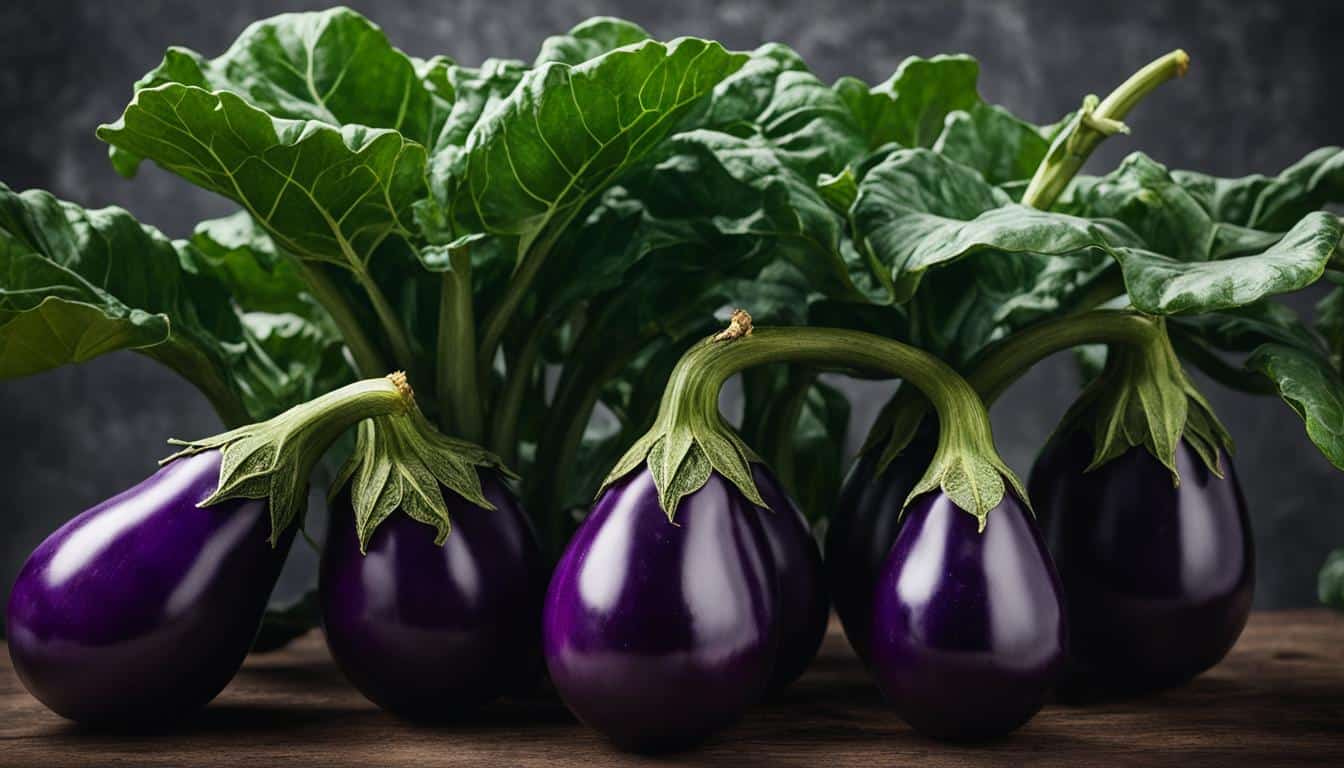



Leave a Reply